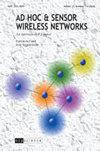Towards a Distributed Congestion Control mechanism for Smart Grid Neighborhood Area Networks
IF 0.6
4区 计算机科学
Q4 COMPUTER SCIENCE, INFORMATION SYSTEMS
引用次数: 3
Abstract
The need for significant improvements in the management and efficient use of electrical energy has led to the evolution from the traditional electrical infrastructures towards modern Smart Grid networks. Taking into account the critical importance of this type of networks, multiple research groups focus their work on issues related to the generation, transport and consumption of electrical energy. One of the key research points is the data communication network associated with the electricity transport infrastructure, and specifically the network that interconnects the devices in consumers' homes, the so-called Neighborhood Area Networks (NANs). In this paper, a new distributed congestion control mechanism is proposed, implemented and evaluated for NANs. Besides, different priorities have been considered for the traffic flows transmitted by different applications. The main goal is to provide with the needed Quality of Service (QoS) to all traffic flows, especially in high traffic load situations. The proposal is evaluated in the context of a wireless ad hoc network made up by a set of smart meter devices, using the Ad hoc On-Demand Distance Vector (AODV) routing protocol and the IEEE 802.11ac physical layer standard. The application of the proposed congestion control mechanism, together with the necessary modifications made to the AODV protocol, lead to performance improvements in terms of packet delivery ratio, network throughput and transit time, fairness between different traffic sources and QoS provision.智能电网邻域网络分布式拥塞控制机制研究
对电能管理和有效利用的重大改进的需求导致了从传统电力基础设施向现代智能电网网络的演变。考虑到这类网络的关键重要性,多个研究小组将工作重点放在与电能的产生、运输和消耗有关的问题上。其中一个重点研究点是与电力运输基础设施相关的数据通信网络,特别是连接消费者家中设备的网络,即所谓的邻里局域网(NANs)。本文提出了一种新的分布式拥塞控制机制,并对其进行了实现和评估。此外,针对不同应用程序传输的流量,考虑了不同的优先级。主要目标是为所有流量流提供所需的服务质量(QoS),特别是在高流量负载情况下。该提案在由一组智能电表设备组成的无线自组织网络的背景下进行评估,使用自组织按需距离矢量(AODV)路由协议和IEEE 802.11ac物理层标准。所提出的拥塞控制机制的应用,加上对AODV协议所做的必要修改,在分组传送率、网络吞吐量和传输时间、不同流量源之间的公平性和QoS提供方面带来了性能改进。
本文章由计算机程序翻译,如有差异,请以英文原文为准。
求助全文
约1分钟内获得全文
求助全文
来源期刊

Ad Hoc & Sensor Wireless Networks
工程技术-电信学
CiteScore
2.00
自引率
44.40%
发文量
0
审稿时长
8 months
期刊介绍:
Ad Hoc & Sensor Wireless Networks seeks to provide an opportunity for researchers from computer science, engineering and mathematical backgrounds to disseminate and exchange knowledge in the rapidly emerging field of ad hoc and sensor wireless networks. It will comprehensively cover physical, data-link, network and transport layers, as well as application, security, simulation and power management issues in sensor, local area, satellite, vehicular, personal, and mobile ad hoc networks.
 求助内容:
求助内容: 应助结果提醒方式:
应助结果提醒方式:


